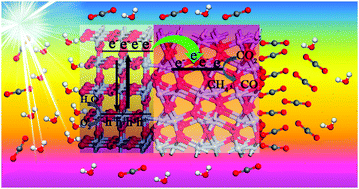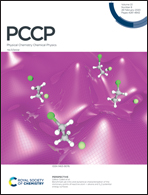Ti2O3/TiO2 heterophase junctions with enhanced charge separation and spatially separated active sites for photocatalytic CO2 reduction†
Abstract
It is strongly desired to develop highly active photocatalysts for CO2 reduction by accelerating charge separation and realizing spatially separated active sites. In this work, Ti2O3/TiO2 heterophase junctions with enhanced charge separation and spatially separated active sites were facilely prepared via in situ thermal oxidation of commercial Ti2O3 in air at an appropriate annealing temperature. The as-prepared Ti2O3/TiO2 heterophase junctions, especially the temperature-optimized T550 sample, displayed high photocatalytic activity for CO2 reduction to yield CH4 (∼0.65 μmol g−1 h−1), CO (∼2.64 μmol g−1 h−1) and O2 (∼5.66 μmol g−1 h−1), which was 4 times higher than that of bulk Ti2O3 and nearly 2 times higher than that of rutile TiO2. Based on the surface photovoltage spectra, related produced OH radical measurement and electrochemical reduction, the high photoactivity could be attributed to the metallic Ti2O3, which trapped the photogenerated electrons from TiO2 through the formed Ti2O3/TiO2 heterophase junctions to enhance charge separation. Remarkably, it was confirmed from theoretical calculations based on density functional theory, Kelvin probe and CO2-TPD measurements that the Ti2O3/TiO2 heterophase junction possesses spatially separated active sites for CO2 reduction and water oxidation. Metallic Ti2O3 as a reduction site activated and catalyzed CO2 to produce solar fuels such as CO and CH4, while TiO2 as an oxidation site oxidized H2O to produce O2 and protons. The designed concept of heterophase junctions and simultaneously activating CO2 and H2O at different spatial sites may offer a new strategy to suppress the reverse reactions during photocatalysis for efficient solar energy conversion.



 Please wait while we load your content...
Please wait while we load your content...